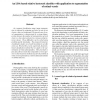Free Online Productivity Tools
i2Speak
i2Symbol
i2OCR
iTex2Img
iWeb2Print
iWeb2Shot
i2Type
iPdf2Split
iPdf2Merge
i2Bopomofo
i2Arabic
i2Style
i2Image
i2PDF
iLatex2Rtf
Sci2ools
ICPR
2010
IEEE
2010
IEEE
An LDA-Based Relative Hysteresis Classifier with Application to Segmentation of Retinal Vessels
In a pattern classification setup, image segmentation is achieved by assigning each pixel to one of two classes: object or background. The special case of vessel segmentation is characterized by a strong disproportion between the number of representatives of each class (i.e. class skew) and also by a strong overlap between classes. These difficulties can be solved using problem-specific knowledge. The proposed hysteresis classification makes use of such knowledge in an efficient way. We describe a novel, supervised, hysteresisbased classification method that we apply to the segmentation of retina photographies. This procedure is fast and achieves results that comparable or even superior to other hysteresis methods and, for the problem of retina vessel segmentation, to known dedicated methods on similar data sets.
Computer Vision | ICPR 2010 | Pattern Classification Setup | Retina Vessel Segmentation | Vessel Segmentation |
| Added | 02 Sep 2010 |
| Updated | 02 Sep 2010 |
| Type | Conference |
| Year | 2010 |
| Where | ICPR |
| Authors | Alexandru Paul Condurache, Alfred Mertins |
Comments (0)

